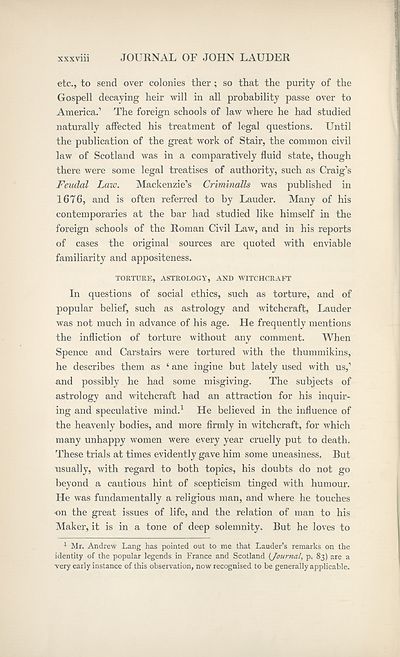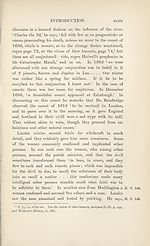Series 1 > Journals of Sir John Lauder, Lord Fountainhall, with his observations on public affairs and other memoranda, 1665-1676
(51) Page xxxviii
Download files
Complete book:
Individual page:
Thumbnail gallery: Grid view | List view

xxxviii JOURNAL OF JOHN LAUDER
etc., to send over colonies ther ; so that the purity of the
Gospell decaying heir will in all probability passe over to
America.’ The foreign schools of law where he had studied
naturally affected his treatment of legal questions. Until
the publication of the great work of Stair, the common civil
law of Scotland was in a comparatively fluid state, though
there were some legal treatises of authority, such as Craig’s
Feudal Law. Mackenzie’s Criminalls was published in
1676, and is often referred to by Lauder. Many of his
contemporaries at the bar had studied like himself in the
foreign schools of the Roman Civil Law, and in his reports
of cases the original sources are quoted with enviable
familiarity and appositeness.
TORTURE, ASTROLOGY, AND WITCHCRAFT
In questions of social ethics, such as torture, and of
popular belief, such as astrology and witchcraft, Lauder
was not much in advance of his age. He frequently mentions
the infliction of torture without any comment. When
Spence and Carstairs were tortured with the thummikins,
he describes them as ‘ ane ingine but lately used with us,’
and possibly he had some misgiving. The subjects of
astrology and witchcraft had an attraction for his inquir¬
ing and speculative mind.1 He believed in the influence of
the heavenly bodies, and more firmly in witchcraft, for which
many unhappy women were every year cruelly put to death.
These trials at times evidently gave him some uneasiness. But
usually, with regard to both topics, his doubts do not go
beyond a cautious hint of scepticism tinged with humour.
He was fundamentally a religious man, and where he touches
on the great issues of life, and the relation of man to his
Maker, it is in a tone of deep solemnity. But he loves to
1 Mr. Andrew Lang has pointed out to me that Lauder’s remarks on the
identity of the popular legends in France and Scotland {Journal, p. 83) are a
■very early instance of this observation, now recognised to be generally applicable.
etc., to send over colonies ther ; so that the purity of the
Gospell decaying heir will in all probability passe over to
America.’ The foreign schools of law where he had studied
naturally affected his treatment of legal questions. Until
the publication of the great work of Stair, the common civil
law of Scotland was in a comparatively fluid state, though
there were some legal treatises of authority, such as Craig’s
Feudal Law. Mackenzie’s Criminalls was published in
1676, and is often referred to by Lauder. Many of his
contemporaries at the bar had studied like himself in the
foreign schools of the Roman Civil Law, and in his reports
of cases the original sources are quoted with enviable
familiarity and appositeness.
TORTURE, ASTROLOGY, AND WITCHCRAFT
In questions of social ethics, such as torture, and of
popular belief, such as astrology and witchcraft, Lauder
was not much in advance of his age. He frequently mentions
the infliction of torture without any comment. When
Spence and Carstairs were tortured with the thummikins,
he describes them as ‘ ane ingine but lately used with us,’
and possibly he had some misgiving. The subjects of
astrology and witchcraft had an attraction for his inquir¬
ing and speculative mind.1 He believed in the influence of
the heavenly bodies, and more firmly in witchcraft, for which
many unhappy women were every year cruelly put to death.
These trials at times evidently gave him some uneasiness. But
usually, with regard to both topics, his doubts do not go
beyond a cautious hint of scepticism tinged with humour.
He was fundamentally a religious man, and where he touches
on the great issues of life, and the relation of man to his
Maker, it is in a tone of deep solemnity. But he loves to
1 Mr. Andrew Lang has pointed out to me that Lauder’s remarks on the
identity of the popular legends in France and Scotland {Journal, p. 83) are a
■very early instance of this observation, now recognised to be generally applicable.
Set display mode to:
![]() Universal Viewer |
Universal Viewer | ![]() Mirador |
Large image | Transcription
Mirador |
Large image | Transcription
Images and transcriptions on this page, including medium image downloads, may be used under the Creative Commons Attribution 4.0 International Licence unless otherwise stated. ![]()
| Scottish History Society volumes > Series 1 > Journals of Sir John Lauder, Lord Fountainhall, with his observations on public affairs and other memoranda, 1665-1676 > (51) Page xxxviii |
|---|
| Permanent URL | https://digital.nls.uk/126980349 |
|---|
| Attribution and copyright: |
|
|---|
| Description | Over 180 volumes, published by the Scottish History Society, containing original sources on Scotland's history and people. With a wide range of subjects, the books collectively cover all periods from the 12th to 20th centuries, and reflect changing trends in Scottish history. Sources are accompanied by scholarly interpretation, references and bibliographies. Volumes are usually published annually, and more digitised volumes will be added as they become available. |
|---|


